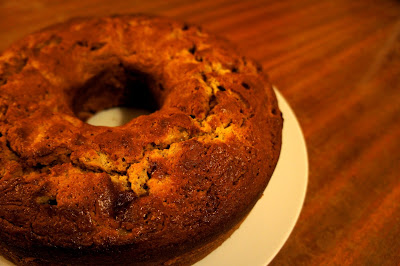Ok, that's an exaggeration. Obviously I bake so I can eat more cake. In truth, it isn't even the competition aspect of the show that has been holding my attention so much as it is the tid-bits that get thrown in, both by the judges and by the competitors, that teach some tricks, techniques and occasionally explain the science behind the baking. My favourite parts, however, are the history of baking segments, which each week feature something relevant to that week's theme. The first episode of this season told the history of the courting cake, which I'd never heard of, but shall be attempting (not for courtship purposes, it looks yummy and unusual - a shortbread base? Yes please!).
This is all to say that I blame The Great British Bake Off for my latest baking endeavour, which I really didn't have time for but proceeded to undertake anyway. The Great British Bake Off, and my own warped desire for pumpkin bread in August.
I picked a well-reviewed recipe for spiced pumpkin bread from epicurious.com, but wanted to experiment with swirling in mascarpone cheese. I knew that mascarpone could be baked as it is sometimes an ingredient in cheesecake, and I believe it is also sometimes baked in the centre of cupcake (another thing I want to try...), so I was mildly surprised to find very few recipes with mascarpone swirls. The recipe closest to what I was imagining that I could find was for brownies. Enter more questioning: If I can't find a suggestion of someone trying this in the vast black hole that is the internet, is there a reason? What will go wrong??
I decided to try it anyway.
In the end, the bread turned out pretty well, and I've added the recipe to the Recipe Box. All in all it's pretty simple, but I made two missteps while figuring it out. The first may be obvious to many bakers, but I'd never learned that you shouldn't grease and flour a pan with oil; butter is the way to go. I was feeling lazy, I already had the oil out, and I thought 'Yeah why not?'. The reason why not is because the flour becomes absorbed, at least in places, by the oil and beads up on the bottom of the pan. I don't really know what would have happened if I'd decided to bake with the pan in that state because I opted not to, but I suspect it wouldn't have been very pretty.
The second misstep was over-beating the mascarpone. I first beat the sugar into the cheese as per the brownie recipe, until the cheese was smooth and creamy. Then I added the ground ginger and, as I was beating, saw the cheese begin to granulate. I immediately realized that of course, like cream cheese, mascarpone can probably be over-beaten. A quick check online informed me that yes, indeed it can. So I beat the egg yolk by itself and carefully stirred it into the cheese mixture, which seemed to work (at least it didn't make it worse), but what I should have done in the first place was to beat the egg yolk with the sugar and ginger, and then mix the mascarpone into that. Lesson learned.
First I prepared the bunt pan (again, with butter), and then made the bread batter. I combined the dry ingredients first so they would be ready for me after I'd beaten the sugar, oil, eggs and pumpkin.
Then I actually beat the sugar, oil, eggs and pumpkin. Mmm, pumpkin...
Finally I prepared the mascarpone mixture. As I said, be careful not to over-beat the cheese; having come out a bit granulated, my swirls survived by could have been better. It seems, however, if the cheese is over-beaten and curdles it will separate when baked.
I poured a layer of pumpkin batter into the bottom of the pan first, and then put dollops of mascarpone mix on top. Next, because the cheese was thick, I swirled the mascarpone with a fork rather than a toothpick. Then I repeated these steps two more times, so that the top layer was swirled with mascarpone. The photo above was taken halfway through the process, and note that the mascarpone doesn't look smooth.
It baked nicely, and actually more quickly than expected. I baked at 325F (160C) rather than 350F because of the cheese, but even at 350F the recipe said to bake for one hour and ten minutes; I pulled it out at about one hour and five minutes, having resisted the urge to pull it out at one hour. I think it would have been just about done at an hour.
No ivory swirls of cheese are visible in these slices, although there were some in a couple of others when I sliced the whole thing up. Primarily the swirls appear as darker, moister streaks in the bread, and I'm not sure if that is because I over-beat the cheese, or if that is how it would always bake. In any case, the swirls are discernible when eating the bread because you get a nice mild pop of ginger, one that I find to be a good complement to the pumpkin spices. I think I'll have another slice now...










